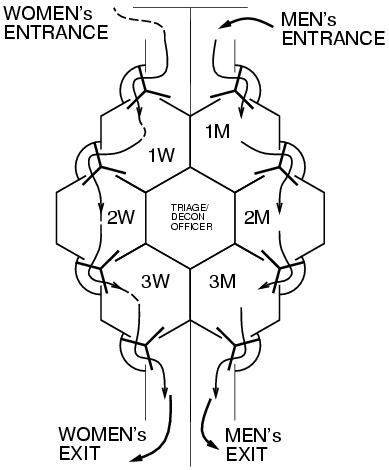
where 1W, 2W, and 3W denote the three stages (1, strip; 2, wash; and 3, cover, respectively) of the Women's pipeline, and likewise 1M, 2M, and 3M for the Men's pipeline.
The need to corral masses of panic-stricken individuals to a decon facility is not just to herd large numbers of persons to the facility, but also to ensure high efficiency and high throughput.
Without pipelining, it typically takes each victim 30 seconds to strip, 30 seconds to wash, and 30 seconds to cover = 90 seconds total = 40 persons/hour throughput.
This assumes the three steps:
However, by having stages, and herding persons through a decontamination line, with pipelining, it is possible then to process persons at a rate of 30 seconds/person = 120 persons/hour throughput. Even though it still takes 90 seconds to process each person, in steady state conditions, persons enter the decon line every 30 seconds, and persons emerge every 30 seconds.
With parallelism in addition to pipelining, a further increase can be obtained. Suppose, for example, that each stage of the pipeline can accomodate six persons at a time (e.g. a six station stripdown room, six station shower, and six station examination/drying/dressing room).
If privacy were not a problem, the throughput could be increased to 720persons/hour.
However, when six persons enter the stripdown room, shower room, and drying room, together, there is a privacy problem. This problem was solved by having separate decon pipelines for men and women, so that the facility could process 720men/hour and 720women/hour. In addition to solving the privacy problem, having these two separate pipelines resulted in additional parallelism: 720men/hour+720women/hour=1440 persons/hour.
The final design is depicted below:

where 1W, 2W, and 3W denote the three stages
(1, strip; 2, wash; and 3, cover, respectively) of the Women's pipeline,
and likewise 1M, 2M, and 3M for the Men's pipeline.
A feature of this space-efficient hexagonal packing is that people never need to turn at angles tighter than 120 degrees, so throughput is very high. Also, the 120 degree angles where walls meet facilitates the installation of high security rotogate turnstiles like those used in unguarded automated subway exits. This ensures that no person can flee from the facility without passing through in the proper direction. Moreover, the hexagonal packing of the six rooms creates lost space in the center. This lost space is actually put to good use as a central triage observation room. The walls of this central room are made entirely of smoked lexan so that guards in the room can have a clear view of activities taking place in the six rooms around the outside, but, for reasons of national security, persons in the six rooms cannot see into the central guard tower. This central triage/observation room also houses computers and video cameras to buffer the video for archival, for quality control and training purposes, and to ensure that safety policy and procedures are complied with.
A mass decon facility, incorporating features of this design, was designed, built, and tested at 80 Spadina Avenue, in Toronto, over the summer of 2001. Final test results in the context of a series of anthrax-free mailroom field trials were completed in July and August 2001.

Next, a support structure is provided for the countertop:

The hexagonal countertop is then moved into position so that walls made of
darkly tinted bulletproof glass, or darkly smoked lexan (polycarbonate)
can be built around it:

The countertop will later be used by decon/triage officers for
setting down their notepads or portable computers.
Six high resolution video cameras are also installed on the countertop,
in case the decon/triage offiers are at a remote location, or to
record video for evidence as victims later move through the decon lines:

Six walls made of smoked polycarbonate are then built around the
countertop with the cameras and computer equipment inside:

To ensure complete total absolute privacy, a black cloth sheet hangs
down the center of the triage observation room, so that men cannot look
into the smoked lexan and see through to the women's side, or vice versa:

Support beams are placed across the top to
provide additional structural integrity:

A black opaque hexagonal cover fits on top of the triage/observation room
(resting on the support beams),
to ensure that it is dark inside the observation room. The darkness
in this room makes it easy to see out into the six surrounding
rooms, but hard for people in the six rooms to see into the central
triage/observation room:

The hexagonal top piece is actually made in two parts, so that it is
easier to lift it up to the top. One part fits over the men's side,
and the other part fits over the women's side. Here is one of the
two halves of the top cover:

Here is what the central triage/observation room
looks like with the cover in place:

Next the showers are installed. Here, to the left of the triage/observation
room, we see the men's showers:
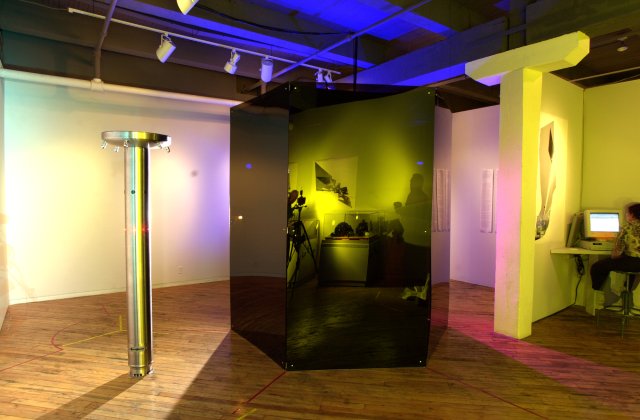
After the showers are installed, six hexagonal rooms are to be built around
the central triage/observation room, together with
high security rotogate turnstiles similar to the turnstiles used
in unguarded subway exits.
The locations where the walls of these six hexagonal rooms
are to be built are marked in red tape, and the positions where the
turnstiles are to be installed are marked in yellow tape:
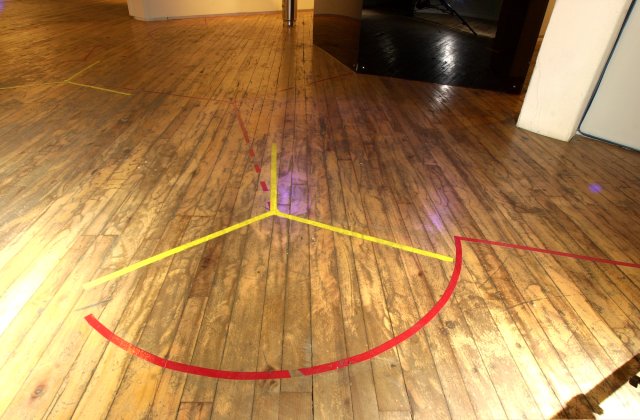
Here we see, for example, the entrance to women's undressing room
showing, in yellow tape, where the rotors of a turnstile will go.
Separate entrances for men and women are to be provided. Three of the six rooms are for men, and the other three are for women.
A Bradley column shower is to be installed in each of the two shower rooms.
A Bradley six station
column shower donated by Bradley Corporation
has already been installed in the men's washdown room:
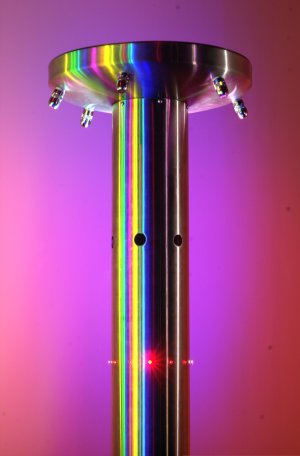
The knobs and soap dishes have been removed from the column shower,
and the holes where these items once were have been replaced with a
machine vision system comprised of 12 laser diode body scanners together
with six round lexan viewing windows moulded into the inside of the
column. There are two laser diode body scanners for each of the
video sensors that are located at each of the six stations,
for purposes of photometric stereo imaging of the bodies
of the users of the column shower.
A set of six video motion detectors with
an Internet connected machine vision computer is to be placed inside each
of the two column showers in the men's and women's washdown rooms.
The system is sealed and completely watertight. Here is a closeup
picture of the six round watertight
viewports of the column shower currently in use in the men's washdown room:
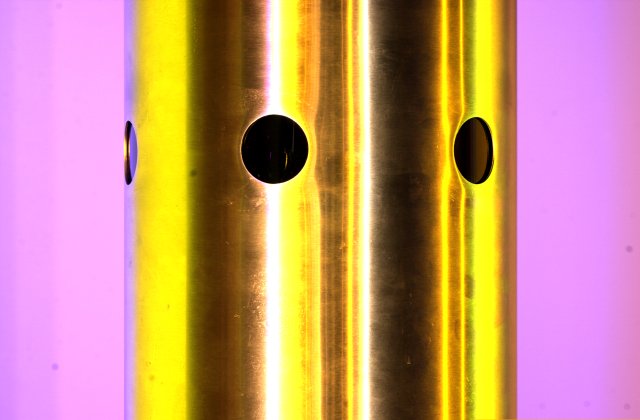
Three of the round smoked lexan viewing windows are visible here.
Up to six men can use this shower at the same time, but only the
number of stations actually being occupied will consume water.
Moreover, water is only consumed when a user is present.
Since there are no knobs or controls of any kind, there is no possibility
for deliberately destructive acts such as might otherwise happen
when users deliberately
(or accidentally) leave the water running.
Each of the six
nozzles face one side of the hexagonal shaped room to maximize
space usage and efficiency.
One of the six walls in each of the six rooms is made entirely of smoked lexan, so that triage personnel or decontamination officers in the central room can supervise the decontamination process, whereas the six or fewer men or women in each room cannot see the triage personnel or decontamination officers, because of the darkness of the lexan (transmissivity is approximately 10 percent, meaning that transmissivity squared is approximately 1 percent, as compared to roughly four percent reflectivity of the surface, such that any visual perception of triage personnel or decontamination officers will fall below a noise floor).
Typically, however, the triage personnel or decontamination officers operate the facility remotely by way of the six video cameras installed in the triage/observation room.

Each video display device sits on a shelf. Each shelf is fitted with
a front surface upon which temporary labels can be affixed with writing
from a marking pen to denote the video feed:

These six video display devices are arranged in a hexagonal formation
at the remote location, as shown below:
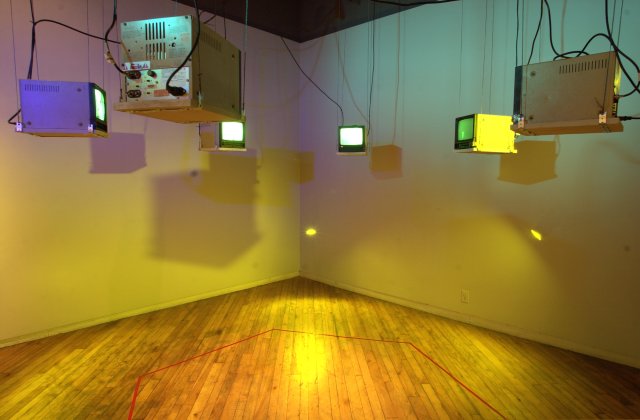
The six television receivers are arranged in the same hexagonal formation as the central triage/observation room.
The four of the six screens that are visible here correspond to (from left to right) the:
Why are we doing this? Here's some excerpts from various government and industry WWW sites.
See also, the final chapter in Cyborg: Digital Destiny and Human Possibility in the Age of the Wearable Computer